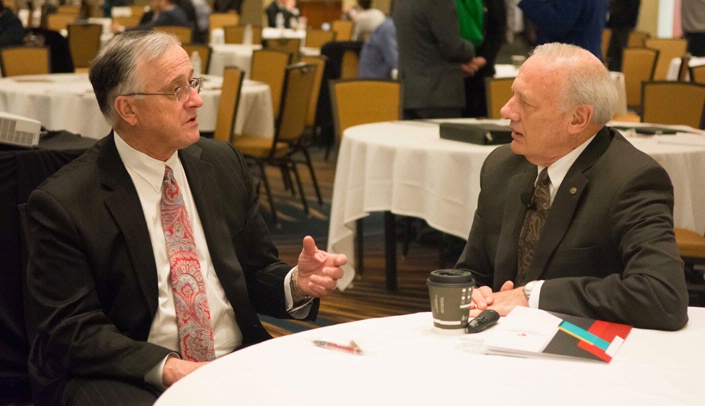Stop and consider: What will America’s health care delivery system look like in 2035?
How do you predict — let alone plan for — such an ambiguous scenario?
Well, the Accreditation Council for Graduate Medical Education (ACGME) is managing that uncertainty by creating four alternative futures, or worlds, in which health care would operate.
“You have to rehearse the future,” said Tom Nasca, M.D., chief executive officer of the ACGME, which accredits residency and fellowship programs. And, while difficult, it’s not impossible to do, he told nearly 230 people at UNMC’s recent Breakthrough Thinking Conference, urging them to “suspend disbelief and engage in the process.”
In fact, UNMC and Nebraska Medicine did just that, he said, in 2005 when they built the country’s largest biocontainment unit and then trained regularly to care for anyone with a highly contagious disease. While they didn’t focus specifically on Ebola, they were able to adapt, and apply, their training when the call came in 2015.
“We need to think creatively about the future so risks are not risks,” Dr. Nasca said. The four scenarios — highlighting external environments within which health care must operate — provided common insights worth noting, including:
- Increased complexity in society and medicine, calling for more seamless interprofessional approaches;
- Increased information transparency;
- Little tolerance for approaches to accreditation, credentialing and licensing with burdensome process inefficiencies;
- Commoditization of health care services, placing a premium on inculcation of professionalism. (Dr. Nasca called this a “threat to all of our collective professions.”);
- No consensus on the future shape (and stability) of health care delivery (provider career flexibility will be crucial);
- Medical education must be capable of supplying a wide variety of physicians by specialty.
Regardless of the future, Dr. Nasca said resilient medical education strategies must:
- Be responsive to societal needs;
- Be forward facing and anticipate the needs of those we serve;
- Be outcomes oriented and evidence-based, whenever possible;
- Promote effective interprofessional, team-based care;
- Provide and promote safety and highest quality patient care; and
- Appreciate how individual patients and society view value in medical care.
Dr. Nasca challenged the audience to think of future scenarios, and how they could best prepare today’s professionals for a 35- to 40-year long career in an ever-changing world. “What do we do if the federal government reduces graduate medical education by 50 percent? Have you thought about that?” Let the scenarios begin.
